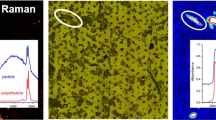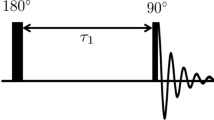Abstract
In this work a 23 factorial design was carried out aiming the multivariate optimization of Instrumental Neutron Activation Analysis (INAA) for mass fraction determination of Co, Cr, Fe, Rb, Sc, Se and Zn in biological samples and Co, Cr, Fe, Sc and Zn in geological samples. The factors investigated in this study were sample decay time, sample distance to detector and sample measurement time. The optimal condition for each method was outlined according to the main effect and interactions results. It was observed that sample decay time is the most important factor for the INAA optimization in the different methods.


Similar content being viewed by others
Notes
Factorial design it is also named in the literature as experimental design, factorial experiment and/or design of experiment (DOE). All these terms are common for the factorial design literature.
References
ISO, International Organization for Standardization (2005) ISO/IEC 17025: general requirements for the competence of testing and calibration laboratories. International Organization for Standardization, Geneva
Zhag WL, Zhang ZB, Cao XH, Liu YH (2014) Uranium adsorption studies on hydrothermal carbon produced by chitosan using statistical design method. J Radioanal Nucl Chem 301:197–205
Reynier N, Blais JF, Mercier G (2013) Optimization of arsenic and pentachlorophenol removal from soil using an experimental design methodology. J Soils Sediments 13:1189–1200
Izadyar S, Fatemi S, Mousavand T (2013) Synthesis and modification of nano-sized TiO2 for photo-degradation process under visible light irradiation; a Placket-Burman experimental design. Mater Res Bull 48:3196–3203
Sanaa NT, Didi MA, Villemin D (2012) Uranium micelle-mediated extraction in acetate medium: factorial design optimization. J Radioanal Nucl Chem 293:789–795
Outola I, Inn K, Ford R, Markham S, Outola P (2009) Optimizing standard sequential extraction protocol with lake and ocean sediments. J Radioanal Nucl Chem 282:321–327
Kurosaky H, Radford R, Filliben J, Inn KGW (2008) An orthogonal design of experiment exploratory data analysis for plutonium contamination. J Radioanal Nucl Chem 276:323–328
Pereira-Filho ER, Poppi RJ, Arruda MAZ (2002) Employment of factorial design for optimization of pyrolysis and atomization temperatures for Al, Cd, Ni and Pb determination by ET AAS. Quim Nova 25:246–253
Teófilo RF, Ferreira MMC (2006) Chemometrics II: spreadsheets for experimental design calculations, a tutorial. Quim Nova 29:338–350
Martínez HDR (2013) Analyzing interactions of fitted models. http://cran.r-project.org/web/packages/phia/vignettes/phia.pdf. Accessed 29 Sep 2014
Eriksson L, Johasson E, Kettaneh-Wold N, Wiktrom C, Wold S (2008) Design of experiments: principles and applications. MKS Umetrics, Umea
Clewer AG, Scanisbrick DH (2011) Practical statistics and experimental design for plant and crop science. Wiley, Chichester
Moreira EG (2010) Preparo e caracterização de um material de referência de mexilhão Perna perna (Linnaeus, 1758). Doctoral Thesis, São Paulo University, São Paulo. http://www.teses.usp.br/teses/disponiveis/85/85131/tde-21062011-093245/en.php. Accessed 29 Sep 2014
NIST Certificate of Analysis: Standard Reference Material 1646a Estuarine Sediment. https://www-s.nist.gov/srmors/view_cert.cfm?srm=1646A. Accessed 29 Sep 2014
Rasch D, Pilz J, Verdooren R, Gebhardt A (2011) Optimal experimental design with R. Chapman & Hall/CRC, Boca Raton
Sheskin DJ (2004) Parametric and non parametric statistical procedures. Chapman & Hall/CRC, Boca Raton
Thompson M (2000) Recent trends in inter-laboratory precision at ppb and sub-ppb concentrations in relation to fitness for purpose criteria in proficiency testing. Analyst 125:385–386
Prichard E, Barwick V (2008) Quality assurance in analytical chemistry. Wiley-LGC, Teddington
NIST/SEMANTECH (2013) e-Handbook of statistical methods. http://www.itl.nist.gov/div898/handbook/. Accessed 30 Sep 2014
Acknowledgments
Authors are indebted to the financial support received from Nuclear and Energy Research Institute (IPEN—CNEN/SP) and the grant from Brazilian National Council for Scientific and Technological Development (CNPq), process number 130022/2013-6.
Author information
Authors and Affiliations
Corresponding author
Rights and permissions
About this article
Cite this article
Petroni, R., Moreira, E.G. INAA method optimization using a 2k factorial design. J Radioanal Nucl Chem 306, 623–629 (2015). https://doi.org/10.1007/s10967-015-4510-x
Received:
Published:
Issue Date:
DOI: https://doi.org/10.1007/s10967-015-4510-x




